Cyrtanthus
Cyrtanthus Ait.
Family: Amaryllidaceae
Common names: fire lily (Eng.); brandlelie, vuurlelie (Afr.)
Introduction
Cyrtanthus is an African genus of bulbous plants, comprising an extraordinary range of attractive flower forms, in a wide range of colours. Many species are suited to cultivation in containers and some make successful bedding plants.
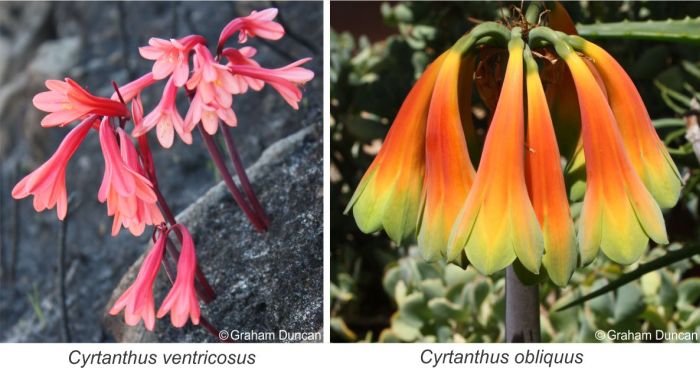
Fig. 1. Cyrtanthus comprises an extraordinary range of attractive flower forms and colours. (Photos Graham Duncan)
Description
Description
These evergreen or deciduous, summer- or winter-growing geophytes reach 110-800 mm high in flower. They grow from a subterranean, partially- or sometimes fully exposed bulb, which is round, or narrowly egg-shaped, and covered with papery, brown, outer tunics, produced into a short or long neck. The bulbs reproduce by formation of offsets and bulblets. The linear, lance-or strap-shaped leaves are erect, suberect or arching, or rarely spirally twisted; they vary from sub-succulent and as narrow as 1.8 mm (e.g. C. guthrieae) to leathery and as broad as 65 mm (e.g. C. obliquus) and may be solitary or produce up to 16 leaves in two opposite rows. One to several flower stems emerge per bulb, often prior to leaf emergence. The flower head (umbel) produces one to numerous tubular, trumpet- or funnel-shaped, scented or unscented, erect to pendent, white, cream, yellow, orange-red, pink, or green-tipped blooms, each produced on a short to long pedicel (flower stalk). The suberect, spreading or recurved tepals are joined below to form a straight, slightly or strongly curved tube up to 65 mm long. Each flower has 6 stamens, usually arranged in two rows, and are included within, or rarely shortly to strongly exserted beyond, the perianth. The fruit is an ellipsoid, oblong or egg-shaped capsule, which, when ripe, splits from the apex downwards, along 3 longitudinal lines. The black, narrowly oval-shaped seeds are flat and surrounded by a black, aerodynamic wing.
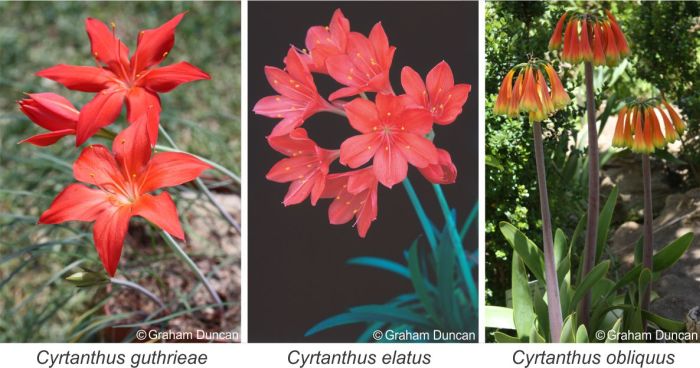
Fig. 2. The linear, lance-or strap-shaped leaves vary from as narrow as 1.8 mm (e.g. Cyrtanthus guthrieae) to as broad as 65 mm (e.g. Cyrtanthus obliquus). Photos Graham Duncan
Conservation Status
Status
Although most southern African species of Cyrtanthus are not threatened, mainly because of their wide distribution or inaccessible habitat, a number are Near Threatened (NT) (e.g. C. staadensis), Vulnerable (VU) (e.g. C. eucallus), Endangered (EN) (e.g. C. leucanthus) or Critically Endangered (CR) (e.g. C. leptosiphon), according to the Red List of South African Plants website. This is mainly as a result of habitat degradation and destruction for urban and agricultural expansion, overgrazing, and the smothering effect of alien vegetation.
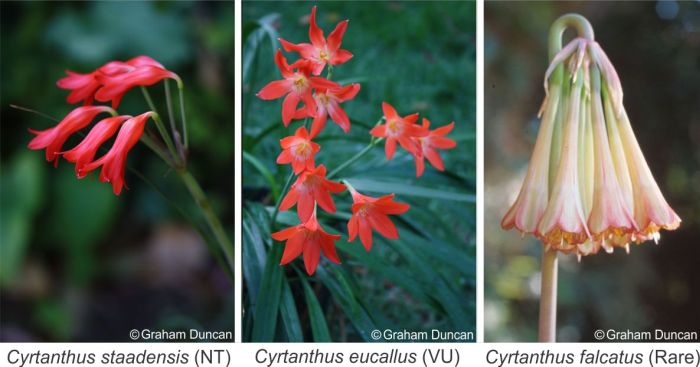
Fig. 3. Although most Cyrtanthus are not of conservation concern, a number are, e.g. the Near Threatened C. staadensis, the Vulnerable C. eucallus and the Rare C. falcatus. Photos Graham Duncan
Distribution and habitat
Distribution description
Cyrtanthus is concentrated in the southeastern and eastern parts of South Africa, and occurs in all countries of southern Africa, except Botswana. It is also represented in East Africa (e.g. Kenya, Tanzania), Central Africa (e.g. Democratic Republic of Congo) and southern Central Africa (e.g. Malawi, Zambia, Zimbabwe). The species occur across a wide range of habitats, including sandy coastal flats, seasonal marshes, rocky mountain slopes, and in subalpine conditions. In summer rainfall areas, many are inhabitants of Albany Thicket (e.g. Cyrtanthus obliquus), and Grassland (e.g. C. tuckii), and in winter rainfall parts, several are endemic to Fynbos (e.g. C. leucanthus). Numerous species are extremely localized, e.g. C. guthrieae and C. leptosiphon from the southern Western Cape. C. breviflorus has the widest distribution, occurring from the Eastern Cape to Limpopo, Kenya and the Democratic Republic of Congo.

Fig. 4. Cyrtanthus elatus, the most widely grown species. Photo Graham Duncan
Derivation of name and historical aspects
History
The Kew botanist William Aiton established the genus Cyrtanthus in 1789 when he described the scarlet-flowered C. angustifolius from the Western Cape. The generic name is derived from the Greek kyrtos, meaning ‘curved’, and anthos, meaning ‘flower’, with reference to the curved perianth in certain species. Several Cyrtanthus were initially published under other genera, such as Vallota (now Cyrtanthus elatus) and Anoiganthus (now C. breviflorus).
With over 55 members, Cyrtanthus is the most species-rich genus of the southern African Amaryllidaceae. C. elatus (George lily, Scarborough lily) is the most familiar species in horticulture, mainly as a container and bedding subject, and sometimes as a cut flower. Other species often grown include C. brachyscyphus, C. falcatus, C. herrei, C. mackenii, C. obliquus and C. sanguineus. Species of Cyrtanthus have also been widely used in the creation of hybrids, including C. elatus, C. brachyscyphus, C. mackenii, C. montanus and C. sanguineus.

Fig. 5. Ripe capsules and seeds of Cyrtanthus flammosus. Photo Graham Duncan
Ecology
Ecology
Bulbs of many Cyrtanthus species produce offsets, whereas others form bulblets beneath the outer bulb tunics, which detach and become independent plants. Several also reproduce vegetatively by means of bulbils at the tips of stolons. Like other members of the Amaryllidaceae, the bulbs contain toxic alkaloids, including galanthamine, haemanthamine, obliquine and tazzetine.
Species with striking, funnel-shaped, bright red or scarlet flowers are pollinated by the large, brown-and-yellow Table Mountain Beauty butterfly (Aeropetes tulbaghia). Those with bright red or orange, tubular flowers (e.g. C. contractus, C. obliquus, C. ventricosus) are pollinated by sunbirds. Various insects, including moths, pollinate those with white or cream, tubular flowers (e.g. C. leucanthus). When ripe, the seed capsules split lengthwise, along three longitudinal lines, from the tip downwards. The light, ripe seeds are aerodynamic, furnished with a papery black wing, and are dispersed by the shaking action of wind, landing some distance away from the mother plant.
Collectively, flowering within Cyrtanthus takes place every month of the year, and especially in autumn, spring and summer. Many mainly spring-flowering species, such as C. breviflorus, C. contractus and C. tuckii, are greatly stimulated to flower by winter wildfires, and certain summer- or autumn-flowering species, including C. aureolinus, C. odorus and C. ventricosus, are entirely dependent on fires at this time of year, for flowering to occur. In C. ventricosus, the response to fire is so strong that flower buds sometimes emerge within just eight days of a fire.
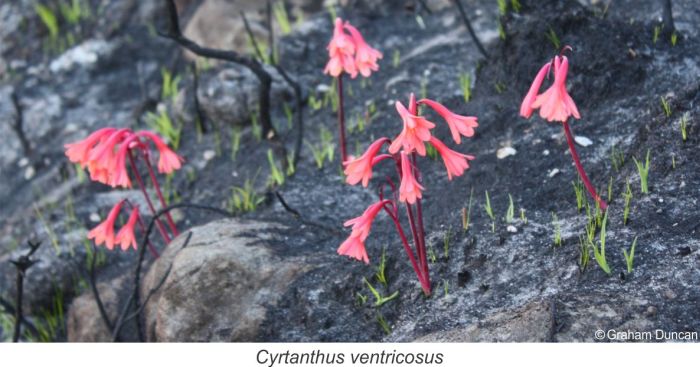
Fig. 6. Cyrtanthus ventricosus flowering directly after fire. Photo Graham Duncan
Uses
Use
Various species of Cyrtanthus are used for medicinal or magical purposes in South Africa. A decoction of the bulb of C. obliquus is used as a remedy for chronic coughs, and the dried bulb tunics are ground to a powder for use as snuff, for relief from headache. The powder is also applied to incisions, to promote healing. C. sanguineus is used as an emetic, and its leaves are added to bathwater. The bulb of C. breviflorus is used to treat intestinal worms, and as a love charm. Bulbs of C. stenanthus are said to be edible, and are used as a charm against lightning. Numerous Cyrtanthus species and hybrids are used worldwide as container and/or bedding plants.
Growing Cyrtanthus
Grow
Cyrtanthus is grown mainly for its striking, sometimes sweetly scented flowers, and certain species have interesting, spirally twisted leaves, or exposed bulbs, covered with papery tunics. The genus comprises two main growth forms, evergreen and deciduous members, and within the latter group there are both summer- and winter-growing species. The evergreen members are usually of easier culture than the deciduous ones, and many of the latter are challenging to grow, and suited only to the specialist grower.
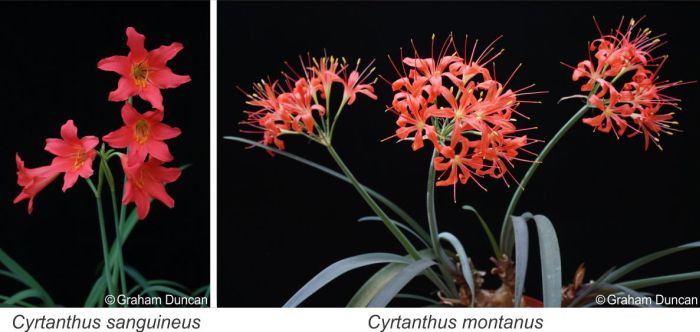
Fig. 7. Two evergreen species, Cyrtanthus sanguineus and C. montanus. Photos Graham Duncan
In general, cyrtanthus like a sheltered but well-ventilated environment, receiving morning sun, or light shade throughout the day, however, certain species, such as the evergreen C. obliquus, thrives in full sun. Many species, especially the smaller ones, are very well suited to containers, placed on a covered patio, or a windowsill. Evergreen species such as C. brachyscyphus, C. elatus, C. mackenii and C. sanguineus, can also be grown in hanging baskets, and these species also perform well as bedding plants. An acid or neutral growing medium that drains well, is preferred, such as equal parts of loam, finely sifted, acid compost and coarse grit/river sand. Depending on mature size, plant the bulbs in 20 cm, 25 cm or 30 cm diam. pots, with the bulb necks exposed. For evergreens and deciduous summer-growers, plant in spring, and for deciduous winter-growers, plant in autumn. In cold climates, terracotta pots are most suitable, but in warm parts, plastic pots are preferable. Provide an initial heavy watering, and repeat once per week or every 10 days for the duration of summer or winter, as the case may be, allowing the medium to dry out substantially between applications of water. During the dormant period, keep the soil dry for deciduous species, and reduce watering of evergreens.
Many cyrtanthus, especially the evergreens, can be propagated by offsets, but some of the deciduous species have solitary bulbs, and are most feasibly propagated by seed. Separate offsets from the mother bulbs in spring, and replant immediately. Certain species, such as C. labiatus and C. montanus, form numerous bulblets beneath the bulb tunics. Remove bulblets when large enough to handle, and establish them in pots for a year, before planting out. Harvest seeds as soon as the dry capsules begin to split, otherwise they will soon be lost during wind gusts. As seed viability is limited, sow seed in containers as soon as it is ripe, in a sandy medium. Alternatively, store seed for up to six months in sealed containers in a fridge, before sowing. Prior to sowing, moisten the soil surface with a watering can, to prevent seeds ‘floating’ to the surface, sow thinly, and cover with 3-5 mm of sowing medium. Germination of fresh seeds takes place within about three weeks. Allow seedlings to establish themselves for two years, before planting out. Cyrtanthus can also be propagated vegetatively by means of bulb explants, under laboratory conditions, however this method is beyond the scope of the home gardener.
In summer, the leaves, flower stems and flower stalks of cyrtanthus are highly susceptible to attack by lily borer caterpillars, which can also destroy the bulbs, in severe infestations. Cyrtanthus bulbs are subject to attack by mealy bugs at any time of year, and snails occasionally freed on the leaves and transfer viral disease. The roots of most species are highly susceptible to fungal disease, usually caused by insufficiently well drained growing media.
References
- Batten. A. & Bokelmann, H. 1966. Wild flowers of the Eastern Cape Province. Books of Africa, Cape Town.
- Duncan, G.D. 2010. Grow bulbs. Kirstenbosch Gardening Series. South African National Biodiversity Institute, Cape Town.
- Duncan, G., Jeppe, B. & Voigt, L. 2016. The Amaryllidaceae of southern Africa. Umdaus Press, Pretoria.
- Duncan, G.D., Jeppe, B.J. & Voigt, L. 2021. Field guide to the Amaryllis family of southern Africa and surrounding territories. Galley Press, Nelspruit.
- Johnson, S.D. & Bond, W.A. 1994. Red flowers and butterfly pollination in the fynbos of South Africa. In: M. Arianoutsou & R. Grooves (eds), Plant-animal interactions in Mediterranean-type ecosystems. Kluwer Academic Press, Dordrecht.
- Moffett, R. 2010. Sesotho plant and animal names and plants used by the Basotho. Sun Press, Bloemfontein.
- Nair, J.J., Bastida, J., Codina, C., Fransesc, V. & van Staden, J. 2014. Alkaloids of the South African Amaryllidaceae: a review. Natural Product Communications 8: 1335–1350.
- Reid, C. & Dyer, R.A. 1984. A review of the southern African species of Cyrtanthus. American Plant Life Society, La Jolla, California.
- Snijman, D.A. & Meerow, A.W. 2010. Floral and macroecological evolution within Cyrtanthus (Amaryllidaceae): inferences from combined analyses of plastid ndhF and nrDNA ITS sequences. South African Journal of Botany 76: 217–238.
- Watt, J.M. & Breyer-Brandwijk, M.G. 1962. The medicinal and poisonous plants of southern and eastern Africa , edn 2. Livingstone, Edinburgh & London.
Credits
Graham Duncan
Kirstenbosch National Botanical Garden
July 2021
Plant Attributes:
Plant Type: Bulb
SA Distribution:
Soil type:
Flowering season:
PH:
Flower colour:
Aspect:
Gardening skill:
Special Features:
Horticultural zones






Rate this article
Article well written and informative
Rate this plant
Is this an interesting plant?
Login to add your Comment
Back to topNot registered yet? Click here to register.